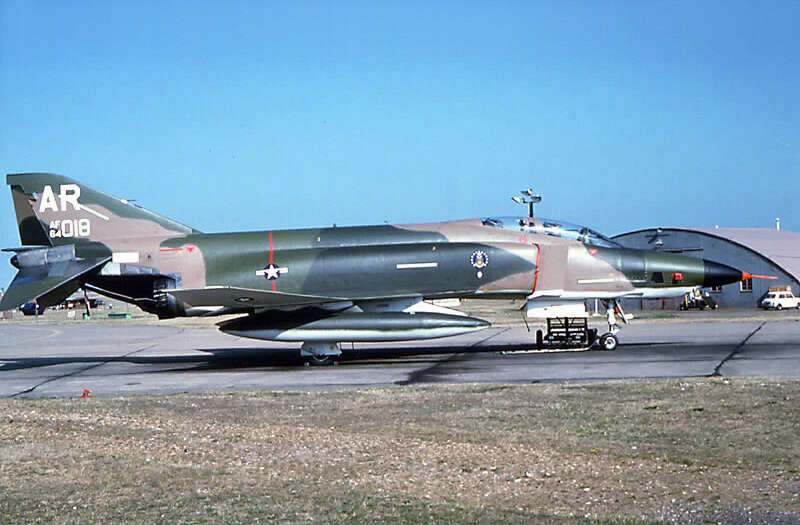
Photo courtesy of Mike at www.f-4.nl
RF-4C 64-1018 at RAF Alconbury in 1970 just before it crashed in Millthorpe.
On 6th May 1970 at approx. 5.35pm, a USAF McDonnell-Douglas RF-4C Phantom II No. 64-1018 of 1st TRS (Tactical Reconnaisance Squadron) / 10th TRW (Tactical Reconnaissance Wing) crashed into Stripes Wood at Unthank near Millthorpe in the Parish of Holmesfield, Derbyshire.
Both crew men ejected and landed at Curbar Edge.

Photo courtesy of Mike at www.f-4.nl
RF-4C 64-1018 at RAF Alconbury in 1970 just before it crashed in Millthorpe.
The crew were on a NATO excercise known as a DCM (Defensive Combat Manouvres) flight from RAF Alconbury in Huntingdonshire. For this kind of mission, one aircraft simulates an attack on the other which must take defensive action. The pilot, Major Donald E. Tokar, aged 37 from Colorado Springs and navigator, Major Peter M. Dunn, aged 34 from Salem, Illinois, were flying slightly behind the lead aircraft's left wing which was crewed by pilot Captain David W. Morgan and navigator Captain Ken L. Lotter. Don Tokar commented that because the RF-4C did not carry any armament, "the only defensive against the enemy aircraft, was to disengage from the attacking aircraft and run!"
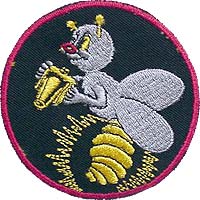 |
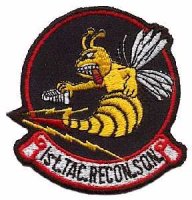 |
|
The emblem of 1st TRS (Tactical Reconnaisance Squadron) as at 1970. The squadron was based at RAF Alconbury as part of 10th TRW (Tactical Reconnaisance Wing)
|
The emblem changed in the mid-1970s to this revised design until the wing became the 10th TFW (Tactical Fighter Wing) in August 1987 with two squadrons of A-10As relocating from the 81st TFW.
|
Once into the flight, David Morgan broke off and began to carry out the simulated attacks. For a time all went well, but during the recovery from a 'nose low, high speed run', the flight controls of Don Tokar's aircraft would not respond. After a brief period of trying to regain control, Tokar gave the order to bale out and Dunn ejected safely. Seconds later, Tokar followed. Pete Dunn's parachute had a slight tear so he descended faster than Don Tokar, landing on top of Curbar Edge on level ground. He sustained only minor bruises and scratches as he was dragged along the ground until he collapsed his parachute.
Don Tokar drifted into crags below Curbar Edge where he suffered bruising and a fractured right leg (femur) as he hit a rock on landing.
Photo from Dave Earl's website High Ground Wrecks in the UK & Ireland.
Major Don Tokar pictured at Tan Son Nhut, Saigon, Vietnam
with his weather worn RF-4C Phantom.
One of the first people on the scene where the crew landed was Clive Mounsey of Edgemount View, Curbar. His wife shouted to him that she could see a parachute descending on Curbar Edge. Immediately, he and a neighbour drove to the Top of Curbar Gap to go to the assistance of the injured Don Tokar. Mr Mounsey said, "as we drove to the scene, we could see the pilot's parachute dropping over the edge of a cliff. He was very lucky not to have been dragged over the edge. The pilot's only concern was for the safety of his navigator. He was found about a quarter of a mile away lying about eight feet away from a sheer drop. It was unbelievable, when we got to him, he just turned round and said, "my name's Pete Dunn, what's yours?" He helped the navigator get his survival radio which he had dropped nearby to enable him to talk to the planes circling overhead.
Ken Adlington of Warren Lodge, Curbar, was also one of the rescuers. He said, "I heard planes circulating around making an unusual sort of sound. As I neared home I saw the parachutes. One was hanging over the edge. The pilot thanked his English ejection seat for saving him."
Brian Whittaker of Green Close, Curbar was a former cross country runner. He dashed three-quarters of a mile to where the parachutes landed. Mr. Whittaker said, "I chatted to Peter Dunn for about five minutes. He was very cool and spoke to the other planes on his radio. He shook hands and took my name and address."

A battered and bruised Major Peter Dunn recovers from his ordeal with a welcome tot of whisky.
Picture courtesy of Peter Dunn - Col. USAF (ret)
The two rescued crew members were eventually tended by medical crews which included a physician. Don Tokar's leg was stabilised and he was given an injection for the pain. He was then carried by stretcher down from the hillside and taken to a clearing by the ambulance where he was reunited with Pete Dunn and eventually taken to RAF Finningly near Doncaster by a helicopter which had travelled from RAF Leconfield to Curbar. They subsequently returned to RAF Alconbury in a USAF helicopter, very lucky to have escaped the stricken jet.

Major Don Tokar receiving first aid to his broken leg on the rocks at Curbar Edge.
Note the RAF Rescue helicopter waiting to take the crew to RAF Finningly.
Picture courtesy of Peter Dunn, Col. USAF (ret).
Don Tokar was then transferred to a USAF hospital at RAF Lakenheath. No surgery was required but his right leg was put in traction for about 4 weeks. Following intensive rehabilitation he returned to RAF Alconbury for further recovery. The only permanent damage being his right leg is now 3/4" shorter than the left. He was once a fluid middle distance runner, having been on his university's track team in Minnesota. The crash ended his running days.
One mystery was the location of the ejector seats which were nowhere to be found, despite extensive searches of Curbar Edge for them. Holmesfield resident Richard Hewins recalled that a reward was offered for their safe return, so the invesigators must have presumed they were by now in the hands of eager souvenir hunters! The safe return of the ejector seats was needed because they may have yielded vital clues as to what may have caused the crash. One was finally discovered near the junction of Baslow Road and Fox Lane, about 20 yards up the lane heading towards Ramsley Reservoir by local walker and writer, Roger Redfern.
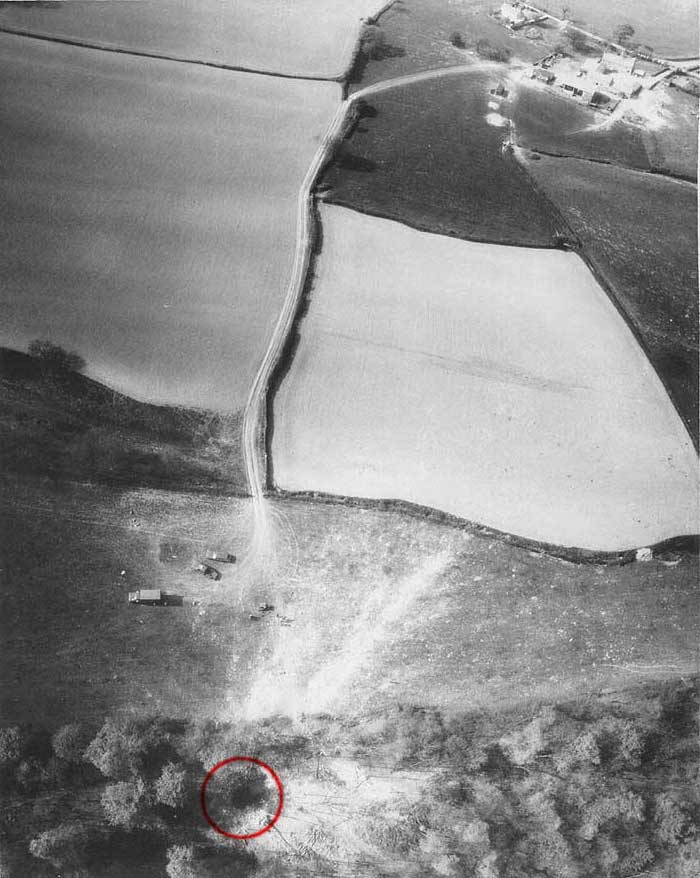
USAF photo of the crash site - the impact crater is shown circled with Neville Biggin's farm visible at the top.
Picture courtesy of Peter Dunn, Col. USAF (ret).
Fortunately there were no injuries on the ground either, as the Phantom crashed in flames into the wooded hillside, where smashed treetops betrayed the plane's plunge to earth following a steep dive. Most of the debris was thrown over a half mile radius - some further - as the jet smashed more than 20 feet into the ground.
The late Herbert Lowe who owned an adjoining farm said he saw someone shooting in the wood at the time of the crash but fortunately, although he was ony a matter of yards away, he was standing "upwind" of the crash. It is not recorded what this individual must have said as he dived for cover!
Neville Biggin of Unthank Lane Farm witnessed the jet crashing and said it exploded when it hit the ground, some of the debris hitting his home and a barn which was just 300 yards from the crash site. He added, "I heard this noise which sounded as though the plane was back-firing badly. I knew by the noise it was making it was not going to go far. I went into the yard and saw it coming over the skyline. It was coming straight for me, but it dipped into the wood. It came from Moorhall way. I don't think there was an explosion in the air before the plane crashed. It crashed in to the ground at about 5.35 and a piece of wreckage came through the farmhouse roof. We got planes round here regularly at tree-top height. We have almost been expecting something like this to happen."
His wife, Gladys Biggin, said she had been getting her son Stewart ready to go bird-nesting in the very woods into which the plane crashed when she heard it come over. She said, "there was a loud noise and I saw a pall of smoke and some flames coming from the wood. I ran outside to fetch in my son, Stewart, aged 11 to safety. Things were dropping out of the sky . Something crashed through the cowhouse. I think it was just debris."
After the Phantom crash, and before the Americans could begin to remove the wreckage, some of the local schoolchildren from Penny Acres primary school in Holmesfield went down and removed whatever they could from the remains of the plane. The police subsequently came to the school to collect all the bits and pieces. However, they were not too successful as Ian Biggin remarked that school children traded pieces of Phantom in the playgrounds like todays generation would trade football or Pokeman cards!
Firemen from Dronfield and Chesterfield were rushed to the crash scene and Derbyshire police threw a tight security chain around the area where wreckage littered the fields until American Airforce personnel examined the wreckage. A team of qualified officers began a full investigation into the reasons for the crash.
A Derbyshire Times reporter was the first to be allowed on to the scene of the crash the following morning. He saw at first hand how the aircraft had hit the ground approx. 10 yards inside the wood, making a crater that was 20 feet deep, 50 feet across and destroying several trees. The aircraft exploded into thousands of fragments on impact and only pieces of charred metal, none of which would be easily recognisable as aircraft parts, remain scattered in the woods and the surrounding farmland.
Don Tokar was a very experienced pilot having flown some 150 combat missions in Vietnam from September 1968 to October 1969, and instructed at Air Training Command. He said that it was ironic that he flew all those missions over hostile territory in Vietnam, only to lose an aircraft over peacful England!
Speaking 34 years later, Neville Biggin, now aged 79 and still actively farming the surrounding countryside recalled how John Knight, who himself was on the receiving end of the Millthorpe crash of 1955, was the first to arrive and the first words he said to Neville Biggin were, "when's the third one coming!"
Charles Quinn was one of the first USAF crash rescue firefighters to arrive on the scene from RAF Alconbury. He was a driver of the 011B crash fire fighting truck with a crew of four firefighters and rescue personnel.

C.A. Hernandez, Joey Trezecki, Charles Quinn and Norbert Howard relaxing whilst off-duty.
These were four of the firefighters that responded to the crash.
Photo courtesy of Charles Quinn.
On the day of the crash while on standby, Alconbury control tower came over the radio - "Control tower to crash, Control tower to crash. We have an inflight emergency on an RF-4C. Repeat. We have an inflight emergency on an RF-4C. Pilot experiencing . . . .difficulties".
All crash trucks then took their positions along the runway and waited. Seconds go by. "Control tower to crash, control tower to crash. We have a co-pilot ejection. We have a co-pilot ejection". Further seconds go by... "Control tower to crash, control tower to crash. We have an aircraft down. We have an RF-4C down."
Then the Chief came over the radio - "Chief to Crash One, Chief to Crash One. Follow me. Follow me".
"That's a 10-4, Chief. That's a 10-4", replied the driver of Crahs One and off the base they went to Millthorpe with a police escort and the roads cleared in front of them.
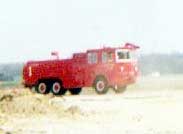 Charles was the driver of Crash One and were the first USAF crash/rescue firefighters to arrive on the scene from RAF Alconbury. They were accompanied by their chief and his team of rescue men. When they got to the crash site it was pretty mucky, the soil was wet and the crash trucks were heavy causing them to sink in the mud. They emptied their fire extinguishing agent onto the huge ball of fire. After they used all of the foam in the truck they were ordered to return to RAF Alconbury to reservice the crash truck in order to be prepared to secure their mission.
Charles was the driver of Crash One and were the first USAF crash/rescue firefighters to arrive on the scene from RAF Alconbury. They were accompanied by their chief and his team of rescue men. When they got to the crash site it was pretty mucky, the soil was wet and the crash trucks were heavy causing them to sink in the mud. They emptied their fire extinguishing agent onto the huge ball of fire. After they used all of the foam in the truck they were ordered to return to RAF Alconbury to reservice the crash truck in order to be prepared to secure their mission.
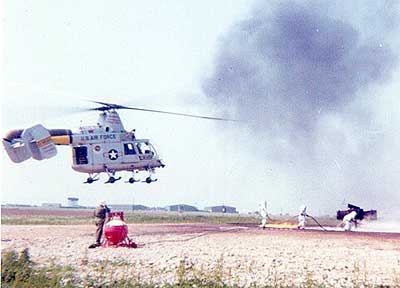
H43 crash-rescue helicopter call signal Pedro from Alconbury
which also answered the call of the crash of 1970. It is shown in training at 'The Pit' at RAF Alconbury.
Photo courtesy of Charles Quinn.
The emergency crash tender military top brass arrived at the scene within an hour of the crash happening! Neville said the police roadblocked the A1 and all roads from Huntingdon all the way to Millthorpe so that they could get to the site as quickly as possibly - not bad for a place that was about 100 miles away!
The following day, more high ranking officials arrived at the scene, this time by helicopter and there was nearly another crash as the helicopter was coming in to land at an adjacent field. As it was descending, another Phantom jet flew underneath it, causing an almighty row which could be overheard coming out of a mobile radio operations room. It was understood that there was an order for the Phantom pilot to "get the hell out of there!" in no uncertain terms! The chastised pilot must have wanted the final word as 10 minutes later he buzzed the area with his engines "on full bore"!
Indeed, the military must have made the crash site a reference point for future missions as it was recounted how jets were becoming a nuisance for the residents of Unthank and the Cordwell Valley by flying past at great speed a couple of times a week for many months. Neville's son, Ian Biggin, commented that you could always tell when there was a military build-up somewhere in the world by the sudden increase in training missions around Milthorpe.
Neville Biggin said how large chunks of wreckage went through the roofs of several buildings, including his dutch barn, cow shed and the gable end of his farm house. A large piece of undercarriage was easy to locate - it was half-buried at the bottom of his garden!
Another unwelcome consequence was mowing the hay. The wreckage that was not picked up wore out the blades on his machinery very quickly and he soon cleared out the local agricultural supplier - Brits of Chesterfield - of knives. In fact the MoD (with whom compensation was dealt with, not the USAF, and who were described as being rather unsympathetic), said that he should have gone to a Retford supplier as theirs were cheaper!
Ian Biggin, was 7 at the time and was visiting his friend John Lowe at the neighbouring farm when the crash happened. He told of the tented village that the Americans erected near the woods and said it looked like a scene from M*A*S*H. His job was to take milk up there in the morning. The temporary camp was there for about 4 weeks or so as airmen were assigned wreckage collection duties, roaming the woods and surrounding fields with buckets, picking up as many pieces as they could find, hauling them all back for further investigation of the cause.
One of the Americans told Ian that they thought the plane must have been travelling at about 800mph when it hit the woods but this was only a guess. What is more certain was that pieces of wreckage were propelled a great distance. The village cricket pitch half a mile away had to be cleared before the next game.
Paul Meggitt, who was a local landscape gardener, was working at nearby Ferney Lee in Unthank laying turf. When he returned from a tea break at the Pewit Cafe near Owler Bar, he discovered bits of the airplane wreckage had damged his newly laid turf.
One way the Americans found to relieve the boredom of collecting small pieces of aircraft was to try and break in a new horse that had come over from Texas and they sometimes turned one of Neville Biggin's fields into a makeshift rodeo. He said that they never did break it in!
Many of the locals befriended their unexpected guests and some were often spotted enjoying a pint of beer at the local pub, the Royal Oak. Schoolchildren were occasionally seen playing football with the servicemen and were invited into the strange american trucks to try some of their pre-packed rations.
Therese Taylor of Holmesfield (now Mrs. Evison of Cutthorpe) was about 11 years old at the time of the crash and remembers it was a sunny evening when her brother Mark shouted that there was a plane that looked as though it was going to crash because a trail of smoke was coming from it. He seemed to know that the pilots had ejected from the plane. As the plane flew over the moors it seemed to be heading in the direction of Rose wood. They promptly dashed down the hill to the crash site, but by this time the area was sectioned off. During the following few days she visited the area when the American Air force had erected tents and remembers chatting to the personnel - amused at the packaged food they had brought to eat.
These must have been exciting times indeed for the village youngsters - and probably the visiting guests.
About six months after the air crash, a group of local people involved in the recovery of the pilots were invited to visit RAF Alconbury as a way of thanking the local people for their help. Peter Dunn wrote the invitation letters himself and anyone who wanted to come, be they policeman or shopkeeper, was welcome. Some came who had not the slightest connection with the rescue and all were welcomed. Peter Dunn met them at the Officers Mess where refreshments waiting for them before being taken on a tour of the installation, including a static display of a Phantom, where many - especially the kids - enjoyed climbing up and sitting in the cockpit. The party were shown the film "Alone, Unarmed and Unafraid" which showed the work of the Reconnaisance RF-4C crews in the Vietnam conflict.
Subsequent to the accident and rehabilitation, Don Tokar returned to flying status (but no longer with Phantoms) with HQ 3rd Air Force based at South Ruislip for a year and then to HQ US Air Forces Europe for two years before being reassigned back to the USA.
Peter Dunn has a British background having been born and raised in India and went to the US after WW II as his father, a Merchant Navy officer, went down with his ship after being torpedoed during the War. Prior to flying RF-4C Phantoms, he had earlier been in B-52s and EB-66s, and from Alconbury he went into F-111s for five years, including a third tour to Vietnam, then to the 20th Tactical Fighter Wing (F-111E's) at RAF Upper Heyford in Oxfordshire, then to a series of commands and he was promoted out of the cockpit to the Joint Chiefs of Staff and the Defense Intelligence Agency in the Pentagon before retirement.
Sources: The Derbyshire Times, The Morning Telegraph (Sheffield), David W. Earl's website - High Ground Wrecks in the UK & Ireland, correspondance between Don Tokar and David W. Earl, correspondance with Peter Dunn, Charles Quinn and Mike Solon. RF-4C graphic courtesy Steve Young.